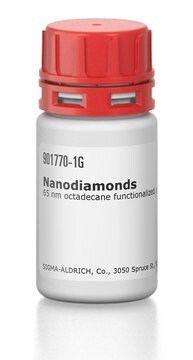483591
Diamond
synthetic monocrystalline powder, ≤1 μm
Se connecterpour consulter vos tarifs contractuels et ceux de votre entreprise/organisme
About This Item
Formule empirique (notation de Hill):
C
Numéro CAS:
Poids moléculaire :
12.01
Numéro CE :
Numéro MDL:
Code UNSPSC :
12352103
Nomenclature NACRES :
NA.23
Produits recommandés
Forme
synthetic monocrystalline powder
Niveau de qualité
Taille des particules
≤1 μm
Densité
3.5 g/mL at 25 °C (lit.)
Application(s)
battery manufacturing
Vous recherchez des produits similaires ? Visite Guide de comparaison des produits
Application
Monocrystalline diamond particles internalized in human endothelial cells have potential applications in drug delivery.
Code de la classe de stockage
11 - Combustible Solids
Classe de danger pour l'eau (WGK)
nwg
Point d'éclair (°F)
Not applicable
Point d'éclair (°C)
Not applicable
Équipement de protection individuelle
Eyeshields, Gloves, type N95 (US)
Faites votre choix parmi les versions les plus récentes :
Déjà en possession de ce produit ?
Retrouvez la documentation relative aux produits que vous avez récemment achetés dans la Bibliothèque de documents.
Micron-sized diamond particles are internalized by endothelial cells.
Walkowiak B, et al.
Diamond and Related Materials, 18, 651-656 (2009)
Pontus Forsberg et al.
Optics express, 21(3), 2693-2700 (2013-03-14)
Control of the sidewall angle of diamond microstructures was achieved by varying the gas mixture, bias power and mask shape during inductively coupled plasma etching. Different etch mechanisms were responsible for the angle of the lower and upper part of
P Pereira Nogueira et al.
The Journal of clinical pediatric dentistry, 37(1), 53-57 (2013-01-25)
The aim of the present study was to evaluate hybrid layer thickness of primary molars sectioned with diamond, carbide and ultrasonic CVD burs. The occlusal enamel surfaces often molars were removed and superficial dentin was exposed. Three standardized cavities were
H Pinto et al.
Journal of nanoscience and nanotechnology, 12(11), 8589-8593 (2013-02-21)
We have investigated using density functional theory the effect of fluorine termination of a (001) diamond surface on the electronic energy levels of an NV- centre buried beneath the surface. We find that, like OH termination, fluorine passivates the surface
Richard W Bowman et al.
Physical review letters, 110(9), 095902-095902 (2013-03-19)
Diamond anvil cells allow the behavior of materials to be studied at pressures up to hundreds of gigapascals in a small and convenient instrument. However, physical access to the sample is impossible once it is pressurized. We show that optical
Notre équipe de scientifiques dispose d'une expérience dans tous les secteurs de la recherche, notamment en sciences de la vie, science des matériaux, synthèse chimique, chromatographie, analyse et dans de nombreux autres domaines..
Contacter notre Service technique